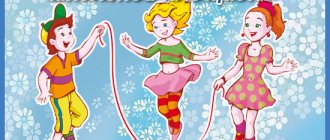It is safe to say that outdoor games for children are the main means of their physical development in preschool and primary school age. After all, in them they receive a mountain of joyful emotions, the opportunity to express themselves and the opportunity for collective communication, as well as the opportunity to take a break from mental work.
This is why all teachers (coaches, physical education teachers, educators, etc.) love to include outdoor games in various classes. The article presents 14 of the most famous and fun outdoor games for children.
- Salki
- Fishermen and fish
- Hunters and ducks
- Crows and sparrows
- Fishing rod
- Kite and hen
- Passed it, sit down
- Rooster fight
- Falling stick
- Who's next
- Jump by jump
- Through a stick
- And run away and catch up
- Balls over the net
Salki
The game "Tag" is designed to develop speed and dexterity.
Location. Hall (platform).
Description of the game. A playing area is determined (for example, one half of a volleyball court). The driver is determined. At the teacher’s command, the driver tries to catch up and touch (smear) all the other players with his hand as quickly as possible. The teacher times the time. After all the players have been named, the driver is told his time (which he remembers) and the next driver is assigned. The game is repeated until all players are the driver. The player whose time is the shortest wins.
Rules.
- The upset player immediately leaves the playing area.
- Players are prohibited from stepping beyond the boundary lines of the playing area. When a player makes a stand, he is considered to have been greased and leaves the game.
Methodical instructions. Depending on the specific objectives of the lesson (development of speed endurance, development of speed, etc.) and the number of students, you can use playing areas of different sizes for the game, and repeat the game several times in a row. In addition, you can vary the method of movement: running, side step, jumping on one leg, etc.
Fishermen and fish
The game is suitable for children of primary school and preschool age and promotes the development of dexterity, speed and endurance.
Location. Gym (corridor, games room).
Preparing for the game. A leading player (“fisherman”) is selected and a playing area is outlined (for example, half of a volleyball court). The remaining players are the fish.
Description of the game. As soon as the teacher gives the command, the “fisherman” begins to catch up with any player and tries to touch him (to touch him). As soon as the player is caught, he and the driver form a “fishing net” (they hold hands) and try to catch up with the other players (“fish”), moving as a pair without separating their hands. Having caught up with the next “fish”, they attach it to the “fishing net” and the three of them catch up, holding hands with all three. Thus, as soon as the next player is defeated, there are one fewer “fish”, and the “net” becomes one player longer. You can end the game when all the “fish” are caught, or when only one “fish” remains, which is declared the winner of the game.
Rule. It is prohibited to let go of your hands during the game (break the “net”). If a player is caught when the net is broken, he remains a “fish”.
You can play several times in a row, changing the size of the playing area and the playing time. In accordance with the objectives of the lesson, the coach can change the direction of the game, focusing, for example, on the development of endurance, or on the development of other motor qualities.
Precautionary measures
An adult who organizes outdoor games for children must clearly know the rules and essence, certain movements, in order to be able to easily explain them to children. Before the start of the game, it is necessary to inspect the site, check special devices, equipment, benches, stands for damage and breakage. Children's shoes and clothing should be appropriate for their age and season, not restrict movement or loosen.
During the game, the adult must organize the children so that they do not injure themselves and each other. You need to instruct your child that when jumping and dismounting, you need to land lightly on your toes, crouching slightly. This will compensate for the body's load on the legs.
It is important to alternate active, energetic games with calm and intellectual games. In the summer, it is better to play in a place on the site where there is shade and coolness. In winter, you need to jump and run more to keep warm.
After the games are over, you need to check how the children are feeling and collect sports equipment and toys. Even though children are warmed up, they should not be given cold water to drink or allowed to walk around undressed in cool weather.
Game "Hunters and Ducks"
“Hunters and Ducks” (“Knocked Out”) is a game to develop reaction speed and dexterity.
Location and equipment. Open area (gym, games room), volleyball.
Preparation. A large circle is drawn on the floor. If the game is played in a relatively narrow hall, then instead of a circle in the middle of the hall, you can draw two lines across, at a distance of 8-12 meters from each other. It turns out to be a rectangle, two sides of which are drawn lines and two sides are the walls of the hall. The players are divided into two (preferably equal) teams - “ducks” and “hunters”. “Hunters”, divided in half, are located outside the drawn circle (or in front of the drawn lines, on both sides). The “ducks” are placed in the middle of the rectangle (or in the middle of the circle), being placed randomly. One of the “hunters” is holding a ball in his hands.
Description of the game. At the teacher’s command, the “hunters”, without entering the circle (without stepping outside the lines), begin to throw the ball among themselves in different directions, trying to hit the “ducks” with it. The “duck” that was hit with the ball is out of the game. The teacher times how long it takes for all the “ducks” to be shot. “Hunters” and “ducks” change roles and continue the game. The team that shoots all the ducks the fastest wins.
Rules.
- When throwing the ball at the “ducks”, the “hunters” are prohibited from stepping outside the circle line (cross line); hitting the “ducks” by players who stepped over the line does not count.
- The “duck” is considered salted if, while dodging the ball, it steps outside the circle (transverse line).
- “Ducks” who have been knocked down do not participate in the game until a change of teams occurs.
When properly organized, the game “Hunters and Ducks” creates a positive emotional background for the lesson and will be interesting not only for children, but also for adults.
Outdoor game for children “Crows and Sparrows”
The game is recommended for children of primary school and preschool age and promotes the development of speed and attention.
Location. A gym or open area with markings for sports games (volleyball, basketball, etc.).
Preparation. All children are divided into two equal teams: “Sparrows” and “Crows”. Teams line up in two lines at a distance of 1-2 m from the center line of the volleyball court (in the middle of the hall) sideways to each other, or with their backs. Thus, the distance between the ranks is 2-4 m, depending on the age of the players and their preparedness. Finally, the teacher determines the optimal distance for specific participants in the game empirically.
Description of the game. The teacher, standing at the center line, pronounces “Crows” or “Sparrows” syllable by syllable, lingering on the last syllable. The team he named must catch up with the other team. You can chase the opponent to the front line of the volleyball court (the beginning of the court from where the serve is made). Players who are “touched” (touched by hand) move to another team. The game ends when there are no players left on either team. In addition to the initial “standing” position, you can use other initial positions (for example, sitting, lying, etc.).
Game "Fishing Rod"
“Fishing Rod” is a game for developing jumping ability, jumping endurance and agility.
Location and equipment. A platform (hall), a rope 3-5 m long, at the end of which some kind of weight is tied (for example, a bag filled with sand).
Preparation. All players are located around the driver (usually the teacher), forming a circle. The driver stands in the middle of the circle and holds a rope in his hands.
Description of the game. The driver begins to rotate the rope with a bag at the end so that it passes under the feet of the players who are trying to jump over it. A player who touches a bag or rope so that the rotation stops is considered greasy and is eliminated from the game, and the driver, starting to rotate the rope again, continues the game. If the player does not touch the rope too much, without stopping its rotation, then he remains in place and the game continues. The last player remaining in the circle is considered the winner. Rule. It is prohibited to move away from your place beyond the rotating rope. Anyone who violates this is considered defiled.
Game options.
- The game "Fishing Rod" can be played as a team game. To do this, before the start of the game, those practicing are divided into two or more teams, and then, all together, stand in a circle. The team whose player remains unspoiled wins.
- The team version of the game can also be played against time. A player who touches the rope or bag is not eliminated, but earns the team a penalty point. The score is announced after each mistake. The winner is the team with the fewest penalty points.
Methodical instructions.
- It is more convenient to rotate the rope, passing its end from one hand to the other, sometimes in front, sometimes behind your back, without rotating yourself.
- To increase the load, you can rotate the rope, lifting it above the floor, to a height of up to 50 cm, or more, depending on the preparedness of the trainees.
By choosing different options for conducting the game, the coach can vary the volume and intensity of the load of the students, thereby solving various tasks of the lesson. For example, by increasing the height of rope rotation and decreasing the playing time, we focus on developing jumping ability; By reducing the height of rotation and increasing the playing time, we focus on developing jumping endurance.
Traffic light
Two boundaries are marked in space - like two sides of a street. The water stands in the middle, with its back to the other children remaining on one side. He names a color and turns to face everyone. Those who have this color in their clothes move to the other “side of the street.” Those who are missing run across, and the water catches them. The one caught becomes new water. In this case, you can name any colors, not just those that are in the traffic light.
Children's outdoor game "Kite and Mother Hen"
The game “The Kite and the Hen” promotes the development of dexterity and instills skills in collective action. Location. Open area (gym, games room).
Preparation. The driver is selected. The other players line up in a column one at a time and put their hands on each other's shoulders. The guide in the column is the “mother hen”, those standing behind the guide are the “chickens”, the leader is the “kite”.
Description. At the teacher’s command, the game begins and the “kite” tries to catch the “chicken” standing at the end of the column. The leader of the column, the “mother hen,” spreads his arms to the sides and protects the chicken, preventing the “kite” from running to the end of the column. The remaining “chickens” also move in different directions, now to the left, now to the right, helping the last “chicken” get away from the “kite”. If the "kite" catches the "chick", then the "kite" becomes the "hen", and the "chick" becomes the "kite".
Rules.
- It is prohibited to lower your hands from your shoulders and break the chain. Whoever breaks this rule becomes a “kite”.
- If the “kite” cannot catch the “chicken” for a long time, another “kite” is appointed.
Game "Pass and sit down"
“Pass and sit down” is a children’s outdoor game to develop dexterity.
Location and equipment. Gymnasium (open area), two volleyballs or medicine balls.
Preparation. Several equal teams can take part in the game. Each team forms a column one at a time. The columns are located parallel to each other, with an interval of 5-10 steps. Each team chooses a captain - a player who is good at throwing and catching the ball. Captains are located at a distance of 5-8 steps from their teams, opposite the guide. A circle with a radius of 1 meter is drawn around the captains. The captains have the ball in their hands.
Description of the game. At the teacher’s command, the captains throw the ball first in the column. Those, having received the ball, return it back to the captains and crouch, then the captains throw the ball to the next in the column, etc. As soon as the captain catches the ball from the last player in the column, he raises it up, thereby informing the referee that his team has completed the game. The team that finishes first is considered the winner.
Rules.
- If a player drops the ball, he must pick it up and throw it to the captain from his seat. If he does not do this, then his team receives a penalty point.
- If a team finishes the game but has penalty points, then that team is considered a loser. In this game you can specify the method of throwing balls.
How are outdoor outdoor games beneficial for children?
Outdoor games have a positive effect on a child’s physical activity and development. Children learn orientation in space, their coordination of movements improves. In addition, energetic games give the child a lot of positive emotions, which have a beneficial effect on his mood and health.
Children who often love outdoor games eat with great appetite, fall asleep easily and sleep soundly, and are less susceptible to whims and sudden mood swings. If a baby leads an inactive lifestyle in early childhood, then at an older age he will quickly get tired.
High physical activity is an excellent prevention of health problems such as muscle weakness and obesity. Most children's outdoor games involve active interaction with other children and adults. Therefore, the child socializes well, learns to quickly react to different situations in life and communicate with peers.
What exactly do street outdoor games develop?
During the game, certain skills are mastered and improved, the work of internal organs of all systems is activated, and brain function improves. Physical, psychological and social qualities develop.
The main physical qualities that enhance outdoor play are:
- Force;
- Agility;
- Flexibility;
- Rapidity;
- Endurance.
Outdoor games, especially competitions, are good for developing analytical thinking in a child. In addition, the following intellectual qualities improve:
- Logics;
- Deduction;
- Critical thinking;
- Abstract thinking;
- Ability to forecast;
- Creative thinking;
- Long-term concentration on solving a specific problem.
By interacting with peers in play, the child learns communication skills, to be tolerant of mistakes, to work in a team, and to solve common problems. Children learn to distribute responsibilities among themselves and share responsibility together. They learn to give in to each other, compromise and listen to the opinions of other children. The main social qualities that joint outdoor games develop in children are:
- Independence;
- Hard work;
- Kindness;
- Courage;
- Honesty;
- Respect;
- Responsibility;
- Self-confidence.
Rooster fight
“Cock Fight” is a game that develops agility and jumping endurance.
Location. Open area (gym, corridor, games room).
Preparation. The game involves two teams that line up facing each other in two lines.
Description of the game. At the coach's command, the players begin to jump on one leg with their hands behind their backs. The goal of the game is to push a player of the opposing team with his shoulder to throw him off balance and force him to touch the floor with his other foot. Whoever touches the floor is out of the game. The team that doesn't have a single player left loses. In the next fight, the participants move on the other leg.
Rule. During the fight, it is prohibited to change the pushing leg and remove your hands from behind your back.
Game option. This game can also be played one-on-one. In this case, the game goes, as they say, “to the winner.” That is, the loser is eliminated, and the next player faces the winner of the previous battle. And so on until the final winner is identified. In order to reduce the time of the fight, it is advisable to play this version of the game in a circle with a diameter of 4-5 meters. In this case, the player who touches the floor with his second foot or goes outside the circle loses.
Methodical instructions. It must be said that the one-on-one version of the game has a very low motor density. Therefore, it is recommended to conduct it in the final part of the lesson, when the “team versus team” version of the game has already been played several times.
Card index of outdoor games on the summer playground for children five to seven years old
Nadezhda Lichman
Card index of outdoor games on the summer playground for children five to seven years old
Outdoor games are very useful. Children play outdoor games with great pleasure. In outdoor games, not only physical abilities are developed, but also mental ones, and moral standards are mastered.
They develop basic movements, relieve mental stress from
educational activities, moral qualities are cultivated.
Fun and exciting games help children cope better with cold weather. Playing together brings children together; children get joy from overcoming difficulties.
Goals of outdoor games:
develops agility, attention, speed, endurance, independence, perseverance, organization, endurance, sense of rhythm, verbal memory, collective interaction, and the desire for mutual assistance.
Medium mobility games
"Golden Gate"
All children participate in the game. They choose two players, they step aside and agree which of them will be the sun and which will be the moon. Then they face each other, hold hands and raise them to form a gate. At the same time they say:
The Golden Gate does not always allow entry:
The first time is forgiven, the second time is forbidden,
And we won’t miss you the third time!
The gate closes at the last words and catches the one who did not have time to pass. The detainee is quietly asked which side he would like to take: the sun or the moon. He chooses and stands behind the corresponding player. The rest go through the gate again, and again one of the participants ends up in the sun or moon group. And so on until all participants are distributed."
Base game "Baba Yaga"
Children create a circle, “Baba Yaga” stands in it, she has a broom (twig). Children move in a circle and say:
Grandma - Hedgehog, a bone leg, fell from the stove and broke the leg!
And then he says: “My leg hurts!”
I went outside and crushed the chicken.
I went to the market and crushed the samovar,
I went out onto the lawn and crushed the bunny.
The children run away, and Baba Yaga jumps on one leg, trying to smear the children with her broom, without running out of the circle. The one whom the presenter insults becomes Baba Yaga.
Base game "Cat and Mice"
The players lead a round dance, in the center of which the mouse is its “house”, pronouncing the words:
[The mice are dancing in a circle, the cat is dozing on the bed,
Hush, mice, don't make noise, don't wake up Vaska the cat:
When Vaska the cat wakes up, he will break up the whole round dance!
As soon as the words are finished, the players raise their hands without opening them - “the doors open”, the mouse runs out and runs from the cat waiting for it outside the round dance.
Base game "Kolobok and the Fox"
- the rules and conditions are the same. Only the words of the text change:
Kolobok, kolobok, toasted side,
Baked in a hot oven, chilled on the window,
And he left his grandfather, and he left his grandmother,
These are the miracles that the fox is waiting for you!
Base game "Cockerels"
The players (one from each team) enter a circle with a diameter of three meters and take the starting position for the fight, crouching on two legs or standing on one (the right hand holds the left leg, and the left hand is bent in front and pressed to the body or vice versa.) Task : push the enemy out of the circle.
Base game "Fishing Rod"
To play you need a rope 2-3 meters long with a weight tied at the end - a bag of sand. The players form a circle, in the center of which stands the teacher with a rope in his hands. He begins to spin it so that it rotates just above the ground. Children jump over a rope. The teacher gradually raises the plane of rotation of the rope higher and higher until one of the participants “falls for the bait,” that is, fails to jump over the rotating rope. The one who got caught drives. Game continues.
Base game "Scarf"
All participants in the game stand in a circle. The driver with a handkerchief follows the circle, puts the handkerchief on one of the players’ shoulders and quickly runs around the circle. The one who was given the handkerchief takes it and runs after the driver. Both of them are trying to take an empty seat.
High mobility games
Base game "Fisherman and fishes"
A large circle is drawn on the site. One of the players - the fishermen - is in the center of the circle, he squats down. The rest of the players, the fish, circle around the circle and say in unison: “Fisherman, fisherman, catch us on a hook.”
At the last word, the fisherman jumps up, runs out of the circle and begins to chase the fish, which scatter throughout the area. The one who is caught becomes a fisherman and goes to the center of the circle.
Base game "Burners"
The participants in the game stand in pairs at the back of each other's heads. The teacher stands in front of all the pairs and says loudly:
Burn, burn clearly so that it doesn’t go out.
Look at the sky: the birds are flying,
The bells are ringing.
One, two, three, last pair, run!
After the last word “run,” the players of the last pair run forward (each on their side) to the designated place, and the teacher tries to delay one of the runners with a touch of his hand until the players meet. The one who was detained stands next to the teacher in front of the first pair, and the second becomes the driver. Game continues.
Base game "Penguins"
The children are lined up around the perimeter of the court, one after another, with a ball sandwiched between their knees. For 15-20 seconds (while the tambourine sounds), children jump forward. Those who lose the ball temporarily leave the game and then stand at the back of the column. The game repeats itself.
Base game "Sleeping Fox"
They choose a "fox". She goes to the corner of the site (burrow) and “falls asleep” soundly (closes her eyes). On the opposite side of the site, beyond the line, is the “house of the hares.” They frolic on the playground, running in different directions. At the teacher’s signal: “The fox has woken up!” “The hares, fleeing from the “fox,” run to the “house.”
“The fox catches “hares” (touches with his hand). The “fox” takes those caught to a hole.
This is only a small part of the games.
Game "Falling Stick"
“Falling Stick” is an active game for developing attention and dexterity.
Location and equipment. Playground (gym, corridor, games room), gymnastic stick.
Preparation. Participants line up in order and stand in a circle. The driver is selected, picks up a gymnastic stick and stands in the middle of the circle. If there are many players, then they form 2-3 circles. Accordingly, the number of driving and gymnastic sticks increases. The driver receives a stick, places it with one end on the floor, vertically, and holds the other end from above with his hand.
Description of the game. The driver, holding the stick with his hand, loudly calls the player’s number and releases the stick. The named player must quickly run up to the stick and grab it before it falls. If he manages to do this, he returns to duty, and the former player remains the driver. If he does not have time and the stick falls to the floor, then this player becomes the driver. The former driver takes his place in the ranks under his number.
Rule. First, the driver calls out someone’s number, and only then releases the stick. If he does the opposite, he must replay this play.
Methodical instructions. The distance from the player in the center of the circle to the rest (diameter of the circle) depends on the preparedness of the players and their age.
Game "Who's Next"
“Who's Next” is a game to develop jumping ability.
Venue and equipment. Hall (platform), chalk.
Description of the game. Two equal teams play. A line is drawn on the site. The first team player performs a long jump from the line. A line is drawn at the landing site (on the heels). Another player of the same team stands at the newly marked line and also jumps forward. His landing is marked at the heels, with a line. All team players jump like this. Then the other team starts the game, starting their jumps from the same starting line, but a little to the side so as not to get confused. The result of the competition is determined when the last player of the second team jumps. If he advances further than the last player of the first team, then the second team wins. Otherwise, the second team is considered the loser.
Rules.
- You need to jump without stepping over the line.
- If a player falls after a jump, a line marks the place where he touched the court with any part of his body closest to the starting line.
The quieter you go, the further you'll get
The driver stands with his back to the other children at a great distance and says: “You drive more quietly, you will go further, stop.” While he is speaking, other children run towards him, but at the word “stop” they freeze in place. The water turns sharply and notices the one who did not have time to freeze - he is eliminated. The goal is to run to the driver and cross the conventional line on which he stands.
Game "Jump by Jump"
“Jump by Jump” is a children's outdoor game to develop jumping ability, agility and coordination.
Location and equipment. Hall (ground, corridor), jump ropes.
Preparation. The game involves two teams with an even number of players each. Each team lines up in a column of two. Each pair of columns holds the rope at a height of 50-60 cm from the floor.
Description of the game. At the teacher’s signal, the players of the first pair in each team put the jump rope on the floor and run to the rear of the column. Next, all pairs standing in the column jump over the jump ropes in sequence. Having jumped to their rope, they take it in their hands and hold it at a height of 50-60 cm from the floor. Then, the players of the second pair put down the rope, jump over the rope of the first pair, run to the tail of the column and jump over all the ropes to their own. All players on each team jump in this manner. The team that finishes the jumps first wins.
Rules.
- The next pair begins jumping after the players in front of the pair have taken the rope in their hands.
- The players of each pair jump with a push from two legs.
- The last pair in the column, returning to their place, raises the rope up, indicating that the team has finished the game.
Game "Through a Stick"
“Through a Stick” is a children's game for developing dexterity.
Location and equipment. Hall, playground, gymnastic sticks.
Preparing for the game. The players are divided into two equal teams and line up in a column, one at a time. The distance between the columns is 8-14 m. The distance between those playing in the columns is arms outstretched forward. Two players from each team stand in front of their column, facing it, holding a gymnastic stick in their hands.
Description of the game. At the teacher’s signal, the first two players (with a stick) carry the stick along their column, and everyone standing in the column takes turns jumping over the stick. Having reached the end of the column, one of the pair (by agreement among themselves) stands at its end, and the second returns to the beginning of the column and, together with the guide, carries the stick along the column. The one who runs twice remains at the end of the column, and the second runs to its beginning and makes a new pair with the player in front. The team whose members are the first to finish the run and return to their starting position wins.
Game option. The formation and scoring system are the same, but at the coach’s signal, the first person in the column carries a gymnastic stick, over which the entire column jumps. Once at the end of the column, the stick is passed on the right side to the person in front of the column.
Ali Baba
Children are divided into two teams and stand holding hands, facing each other. The distance between them is approximately 6 meters. The older the children, the greater the distance may be. One team shouts: “Ali Baba!” The second replies: “About what, servant?” The first one answered them: “Fifth or tenth, Petya is here for us!” The child named from the opposite team runs as fast as he can towards the opponents’ wall, breaking the chain with himself. Broke - takes someone from this chain to his team, usually someone he sympathizes with. If not broken, the enemy joins the formation. The game continues until one child remains on one side.
Game “And run away and catch up”
“And run away and catch up” is an active game for developing attention, dexterity of peripheral vision and special speed.
Class place. Gym, playground.
Preparing for the game. Before the start of the game, a playing area is determined (for example, half of a volleyball court), after which all players form a circle. Each player must remember his neighbor on the right and left. After this, all the players scatter across the entire court, waiting for the signal to start the game.
Description. At the coach’s signal, each player tries to insult his right neighbor, remembering that he himself is simultaneously being pursued and caught by his left neighbor. If a player is caught, he leaves the court with his hand raised up, thereby notifying that he is out of the game. The player whose right and left neighbors are eliminated from the game goes to the side as the winner.
Rules.
- A player is considered caught if his left neighbor hits him with his hand.
- A player who goes out of bounds is considered caught.
Methodical instructions. Depending on the number of participants, their age and training, the game can be played in playing areas of different sizes.
Waves with a skipping rope
One of the most fun games with a jump rope is waves. Two people hold the rope at both ends, twisting it near the ground and gradually lifting it higher, increasing the waves. The rest of the children jump to one side and the other without touching the jump rope. Or they “dive” under the waves. The one who is touched by the jump rope is eliminated from the game.
Tell your child about the games of your childhood, play with him, initiate games among children and their friends. While playing, the child learns to quickly dodge, fall safely, run at full speed and jump with the feeling of flying. The game is about freedom, joy and spontaneity. About an open-minded perception of the world. By playing, a person gets rid of fears and pressures, and the release of energy occurs in the right direction. Outdoor games for children contain a lot of reasons for improvisation. Playing is exciting, exciting, it makes the child more self-confident and helps him feel his freedom of choice, strength and speed, given by nature.






